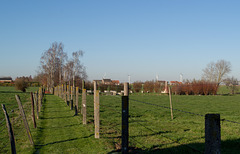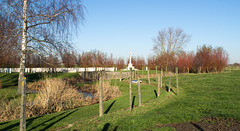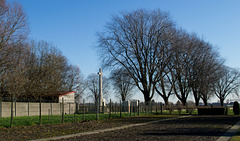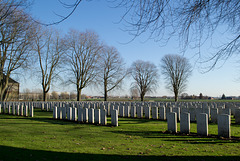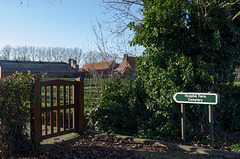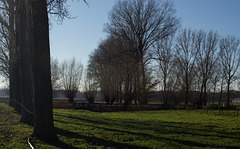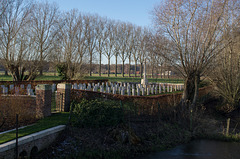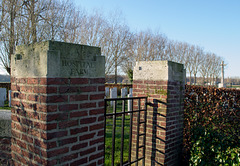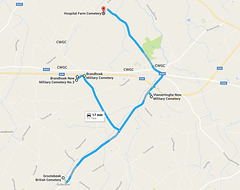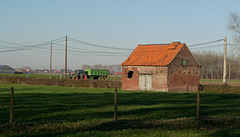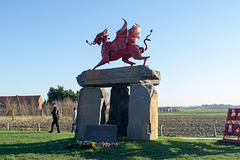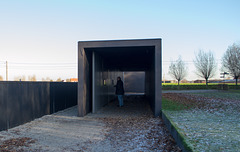
Europe2016
Belgium Brandhoek New Military Cemetery (#0312)
| |
|
|
|
Brandhoek New Military Cemetery is behind a row of houses and accessible by a narrow grass path between two houses. Brandhoek New Military Cemetery contains 530 Commonwealth burials and 28 German war graves; burials were from two months in 1917 (July and August). (The scaffolding on the left edge is from rebuilding the entrance gate.)
Belgium Grootebeek Cemetery (#0313)
Belgium Grootebeek Cemetery (#0315)
| |
|
|
|
The cemetery is named for the narrow stream seen running alongside the cemetery. The cemetery contains 109 burials from WWI and 2 from WWII.
Belgium Grootebeek Cemetery (#0318)
| |
|
My hotel in Ypres had provided a detailed map of Commonwealth graves in the general area, with recommendations for ones to visit. Since I’m allergic to focusing on recommended sites, I looked at the map and decided to focus on cemeteries in what seemed to be odd locations (some of which were recommended). I learned quickly that if you looked closely while driving, there were signposts indicating the directions to cemeteries, which is how I found the sign (but not the cemetery) for Grootebeek British Cemetery, about 5k from the Brandhoek cemeteries.
The sign here points to a grass path between farm fields; there was no official place to park other than just pulling off the road.
Belgium Vlamertinghe New Military Cemetery (#0325)
| |
|
|
One cemetery that I almost drove past, but am glad I didn't, was the Vlamertinghe New Military Cemetery. While driving I saw a cemetery sign seemingly pointing at a row of houses and driveways, it wasn't until circling back that I saw that the sign was pointing down one of the driveways. I parked on the street in a spot that almost looked like someone's private parking spot, and then looked down that driveway. Since it was a marked path, I start walking down it but was expecting someone from one of the houses along the path to come out and tell me (in a language I wouldn't understand) to get off their property. That didn't happen. I'm glad I went, the combination of being isolated, large, looking comparatively woodsy, and closely surrounded by farm buildings and fields, made it seem more connected to nature than was the case with the other cemeteries.
Belgium Vlamertinghe New Military Cemetery (#0319)
Belgium Vlamertinghe New Military Cemetery (#0321)
| |
|
|
The Vlamertinghe New Military Cemetery Cemetery contains 1820 burials; 7 German, 1611 UK, remaining burials are other Commonwealth countries. Most of the burials are from July to December, 1917.
Belgium Hospital Farm Cemetery (#0326)
| |
|
Hospital Farm Cemetery was also relatively difficult to find. Besides the cemetery I had just visited, there were two other Commonwealth cemeteries in or near Vlamertinghe and then the Hospital Farm Cemetery further out. There were signs for all three, but the sign for Hospital Farm was near an intersection where it was difficult to know which road to take. I made a wrong turn and went a fair distance before realizing that wasn't correct. I did, though, find it after a pleasant drive on a narrow road through fields.
Belgium Hospital Farm Cemetery (#0327)
| |
|
|
Reaching the cemetery required walking alongside a farm field; the cemetery is not visible when you first enter the field and the path is not clearly marked, but it was a pleasant day for strolling the fields.
Belgium Hospital Farm Cemetery (#0328)
| |
|
|
Fields of death....The presence of the cemetery in a bucolic spot surrounded by active fields created an almost surreal sense of the extent of mayhem and death that had occurred 100 years before.
Belgium Hospital Farm Cemetery (#0329)
Belgium Hospital Farm Cemetery (#0331)
Belgium CWGC map
| |
|
A Google map of the 6 Commonwealth War Grave Commission cemeteries that I visited. Also noted on the map with "CWGC" are four other Commonwealth War Grave Cemeteries that were within the relatively narrow section that I was visiting. There are 100 British and Commonwealth military cemeteries in the Ypres Salient, all within a relatively small space. The website linked below has a map showing all of them and German (1), French (2) and Belgian (1) WWI military cemeteries: www.greatwar.co.uk/places/ypres-salient-cemeteries.htm
Belgium Hospital Farm Cemetery (#0335)
Belgium Welsh National Memorial (#0336)
| |
|
A sign describing the Welsh National Monument. The monument commemorates the contributions of all Welsh to WWI, from soldiers to those working extra on the home front.
Belgium Welsh National Memorial (#0337)
| |
|
|
|
The monument consists of a bronze dragon, the symbol of Wales, atop a stone slab foundation in a form common to Celtic people. The monument is the only monument to the Welsh, who lost disproportionately more people to WWI than any other country. See: en.wikipedia.org/wiki/Welsh_Memorial_Park,_Ypres
Belgium Ypres Poppy Centopath (#0342)
| |
|
|
|
A remarkable marker that I wish I had known more about at the time. Subsequent searching indicates that the monument was created by an international community of blacksmiths to honor the role of the blacksmiths in WWI who maintained the very large population of horses that were necessary for fighting the war. The Centopath includes the tall central sheet of metal with a poppy cut out, surrounded by a field of 2016 steel poppies crafted by blacksmiths, plus various hand-crafted panels around the square.
The Centopath is next to the German cemetery in Langemark Polkapelle; because my focus was on the German cemetery and it was getting late in the day, I did not spend enough time understanding this monument.
The website linked here contains information on the project, including a fascinating page with pictures on the uses of horses in WWI (between 1914 and 1917, a 1000 horses a day were shipped from the US to Europe): www.ypres2016.com
Belgium Langemark German cemetery (#0343)
| |
|
At the entrance (from the parking lot) to the German cemetery in Langemark. The covered area includes video screens with narrative and photos about German forces in the area during WWI. The videos cover two exceptional facts about the Langemark:
1) ‘Student cemetery’: The cemetery was at first called the ‘student cemetery’ because the initial German troops used in the area were predominantly ill-prepared students who had little military training and were forced into battle ill-prepared, resulting in very high death rates. (multiple sources)
2) Chemical warfare: The Germans are credited with being the first to use poison gas in warfare. That ‘first’ attack involved the release of deadly chlorine gas along a five-mile line that ran through what is now the site of the cemetery. The following website provides a description of gas attacks, including noting that the French were actually the first to use gas in warfare, that there were limited German uses before this attack at Langemark, and that Allied forces quickly picked up the use of gas in their attacks: firstworldwar.com/weaponry/gas.htm
Jump to top
RSS feed- Latest items - Subscribe to the latest items added to this album
- ipernity © 2007-2024
- Help & Contact
|
Club news
|
About ipernity
|
History |
ipernity Club & Prices |
Guide of good conduct
Donate | Group guidelines | Privacy policy | Terms of use | Statutes | In memoria -
Facebook
Twitter


